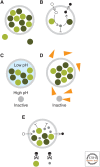Building Spatial Synthetic Biology with Compartments, Scaffolds, and Communities
- PMID: 27270297
- PMCID: PMC4968161
- DOI: 10.1101/cshperspect.a024018
Building Spatial Synthetic Biology with Compartments, Scaffolds, and Communities
Abstract
Traditional views of synthetic biology often treat the cell as an unstructured container in which biological reactions proceed uniformly. In reality, the organization of biological molecules has profound effects on cellular function: not only metabolic, but also physical and mechanical. Here, we discuss a variety of perturbations available to biologists in controlling protein, nucleotide, and membrane localization. These range from simple tags, fusions, and scaffolds to heterologous expression of compartments and other structures that confer unique physical properties to cells. Next, we relate these principles to those guiding the spatial environments outside of cells such as the extracellular matrix. Finally, we discuss new directions in building intercellular organizations to create novel symbioses.
Copyright © 2016 Cold Spring Harbor Laboratory Press; all rights reserved.
Figures


References
-
- Alfano EF, Lentz EM, Bellido D, Dus Santos MJ, Goldbaum FA, Wigdorovitz A, Bravo-Almonacid FF. 2015. Expression of the multimeric and highly immunogenic Brucella spp. lumazine synthase fused to bovine rotavirus VP8d as a scaffold for antigen production in tobacco chloroplasts. Front Plant Sci 6: 1170. - PMC - PubMed
-
- Avila-Calderón ED, Araiza-Villanueva MG, Cancino-Diaz JC, López-Villegas EO, Sriranganathan N, Boyle SM, Contreras-Rodríguez A. 2015. Roles of bacterial membrane vesicles. Arch Microbiol 197: 1–10. - PubMed
-
- Baldi PC, Velikovsky CA, Braden BC, Giambartolomei GH, Fossati CA, Goldbaum FA. 2000. Structural, functional and immunological studies on a polymeric bacterial protein. Braz J Med Biol Res 33: 741–747. - PubMed
Publication types
MeSH terms
Substances
LinkOut - more resources
Full Text Sources
Other Literature Sources
